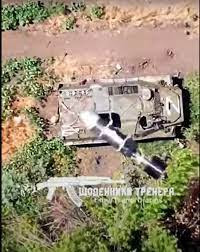Not only can technology be used to target enemy assets, it can be shared in real time to influence public opinion about who is winning and losing - as well as the planning of military strategy which must now take public commentary and reaction into account. JL
Mick Ryan reports in War In the Future:
Social media is influencing perceptions. Thousands of online commentators are informing populations in Russia, Ukraine & other nations. Sophisticated mapping tracks the war (as well as) images and videos which exert influence. Citizen strategic influencers are now a presence in the battle of ideas, (and) regardless of expertise, can shift opinions. Every piece of military hardware and activity possesses a signature. Those that can collect information on the signatures and turn this into timely, actionable products possess a decisive advantage. The pervasiveness of social media means commanders must incorporate the threats and opportunities of social media into planning processes21st century technologies have not only enhanced military lethality at greater distance, but they also now provide new means to inform, as well as target & influence populations in a way that has not been possible before.
Social media is particularly influential. It has the capacity for influencing perceptions of humans that is historically unprecedented, particularly when compared to other means of communication. It is more viral; users are more mobile and more likely to share content. Other wars have been covered by social media. Examples include the Israeli operations in Gaza as well as the application of social media by ISIS during their invasion of northern Iraq. But there has been a broader use of social media in this war.
As has noted, “the invasion of #Ukraine is not the first social media war, but it is the most viral.” The Russo-Ukraine war has provided examples of three important functions of social media in human conflict: 1. Inform; 2. Influence; and, 3. Detect.
Inform. The rise of citizen social media war commentators was noted in a 2013 paper titled The New War Correspondents. But there has been an explosion in this approach during the Russo-Ukraine War.Hundreds, if not thousands, of online commentators & curators – some well credentialed and experienced, some not so experienced – are informing populations in Russia, #Ukraine & many other nations. They have used tweets and other social media.This 'inform' function has traditionally been reserved for war correspondents. But journalists have also adapted, combining traditional reporting approaches with the exploitation of social media and other data to report the war. And the journalists in this war - heroes!
Citizen analysts have also developed sophisticated mapping products to track progress in the war and have shared countless images and videos which all exert some level of influence on those who view them.But because of the demands on rapid reporting, over reliance on social media information (which is more difficult to verify and open to lies and deception) is a risk for policy makers and senior military leaders.Regardless, citizen strategic influencers are now a presence in national & global discourse and in the battle of ideas. Views of social media commentators, regardless of expertise, can shift opinions in democratic and authoritarian nations alike.
Influence. While China and Russia have demonstrated an advanced capability to undertake strategic influence operations, the war in #Ukraine demonstrates that it is possible for democracies to also generate strategic influence.In the lead up to the invasion of Ukraine, intelligence agencies in the United States were able to use sensitive sources and reporting to attempt to pre-empt Russian operations.This sought to discredit Russian narratives about the war, crowd the information space to degrade the impact of Russian influence campaigns, and assist the Ukrainian development of military strategy to defend their nation.Probably the best example of effective influence operations has been the Ukrainian Government, and its President. Ukraine has run a model program to influence western governments and gain aid & diplomatic assistance since the invasion in February. This has been enhanced by efforts to ‘harden’ Ukrainian telecommunications, which has kept their telecommunications network functional, allowing citizen journalists, hacktivists & other individuals to transmit images and commentary on the war, including Russian atrocities.
Detection. Every piece of military hardware possesses a signature. This might be visual, aural or in the electromagnetic spectrum. Every activity has a signature or multiple. Those institutions that can collect information on the various signatures of military organizations and turn this information into timely, actionable products possess a decisive advantage.Signature detection using civilian assets - then shared on social media - has also come to the fore. For example, many commentators and analysts now use the US National Aeronautics and Space Administration (NASA) Fire Information and Resource Management System.And because Russians have often resorted to insecure communications during their invasion, civilian operators as well as military intelligence agencies have been able to intercept, analyse and share sensitive military discussions.
Open-source satellite data is also playing a role in not just Ukraine operations, but also in measuring more strategic activities. It has been used to detect build ups of Russian forces far from the front lines & conduct battle damage assessment of strikes (Crimea, Belgorad). The ability of civilian intelligence agencies, such as , to detect & assess military activity means that military institutions must be even more careful with their signatures in the 21st century. But they might also want to partner with these agencies.
The pervasiveness of social media users in nearly every environment in which humans will fight means military commanders & planners must incorporate the threats and opportunities of social media into the planning processes.




















1 comments:
Other tools include eClincher, which offers competitive intelligence reports, an online dashboard, scheduling features, and live customer support. Promorepublic ( try it) offers a free trial, and you can also buy a paid plan that includes unlimited accounts and brands. You can also choose a plan that suits your budget and your needs.
Post a Comment